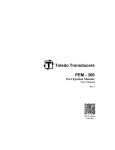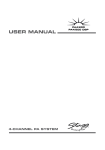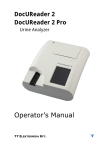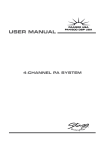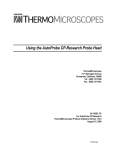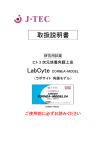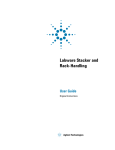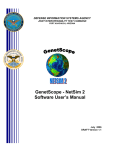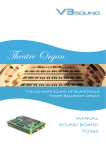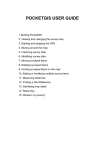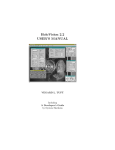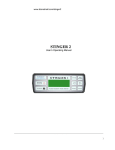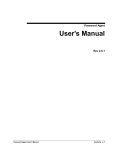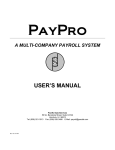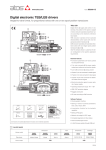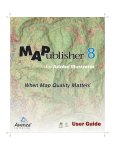Download Echo Cherry Pick User Manual
Transcript
Echo Cherry Pick User Manual Labcyte Part Number: 001-5723 Revision 2 February 2008 The information contained in this manual is subject to change without notice. ® Any unauthorized changes or modifications to the Echo Cherry Pick application will void its warranty. Contact Labcyte Inc. prior to making any change or modification. Copyright © 2008 Labcyte Inc. All rights reserved. Printed in the United States of America. Microsoft, Windows, Windows XP, ActiveX, and Microsoft SQL Server are either registered trademarks or trademarks of Microsoft Corporation in the United States and/ or other countries. Pentium III and Pentium 4 are trademarks or registered trademarks of Intel Corporation or its subsidiaries in the United States and other countries. All other registered or unregistered trademarks used herein are the exclusive property of their respective holders. For research purposes only; not for use in diagnostics. The Echo liquid handler is covered by one or more of the following patents: 6,416,164; 6,548,308; 6,603,118; 6,612,686; 6,642,061; 6,666,541; 6,707,038; 6,710,335; 6,746,104; 6,802,593; 6,808,934; 6,809,315; 6,849,423; 6,855,925; 6,869,551; 6,893,836; 6,893,115; 6,916,083; 6,932,097; 6,938,987; 6,938,995; 6,991,917; European Patent EP 1337325. Additional patents pending in the United States and other countries. ii Table of Contents Preface ............................................................................................. 1 Intended Audience .................................................................................................1 Software Requirements ..........................................................................................1 Manual Organization .............................................................................................2 Manual Convention................................................................................................2 1 Introduction ............................................................................... 3 1.1 1.2 1.3 What is a Pick List? ................................................................................................4 What are the benefits?...........................................................................................6 Documentation ......................................................................................................7 2 Getting Started .......................................................................... 9 2.1 2.2 2.3 2.4 2.5 Start the Software ..................................................................................................9 Activate the Instrument ........................................................................................11 Main Window ......................................................................................................13 Set Up the Software .............................................................................................15 Shut Down the Software ......................................................................................16 3 Software Overview .................................................................. 17 3.1 3.2 3.3 3.4 3.5 3.6 Create Pick Lists...................................................................................................18 3.1.2 Pick List Formats.........................................................................................19 3.1.3 Pick List Header Data..................................................................................23 3.1.4 Pick list file format ......................................................................................25 Set up the Transfer Protocol .................................................................................26 Import Compound and Control pick lists...............................................................29 Run a Simulation..................................................................................................35 Set up Plates........................................................................................................37 Run a Protocol .....................................................................................................38 4 Software Reference ................................................................. 42 4.1 4.2 Toolbar ................................................................................................................43 Protocol ...............................................................................................................44 4.2.1 Source Plate Definition................................................................................44 4.2.2 Destination Definition .................................................................................44 Labware Definitions .............................................................................................46 4.3.1 Plate Type List ............................................................................................46 4.3.2 Plate Type Editor.........................................................................................48 4.3.3 Plate Export................................................................................................51 Pick List ...............................................................................................................52 4.4.1 Compounds and controls window ...............................................................52 4.4.2 Plate Preview window.................................................................................54 4.4.3 Import Compound and Control List windows...............................................55 Protocol Options ..................................................................................................56 4.5.1 Survey History.............................................................................................57 4.5.2 Output Files................................................................................................59 4.3 4.4 4.5 iii 4.6 4.7 4.8 4.9 4.5.3 File Type.....................................................................................................59 Preferences ..........................................................................................................64 Run Protocol ........................................................................................................65 Simulator window ................................................................................................66 Run Status window ..............................................................................................70 iv Preface Intended Audience The Echo Cherry Pick program is designed for use by laboratory personnel. This software application assists the researcher by automating individual sample transfer. Software Requirements To use the Echo Cherry Pick application, you must meet the following requirements: z Echo 5XX Liquid Handler system using software version 2.1 or later. z License key from Labcyte Inc. z Computer system meeting the following requirements: Operating system: Microsoft® Windows® XP SP2 or later; .Net Framework 2.0 CPU: Intel® Pentium® 4 or later (2GHz or greater) Memory: 512 MB or higher Network connection: 10/100/1000 BaseT Network protocol: TCP/IP Hard drive storage: 200 MB Video: 1024 X 768 resolution, 256 colors or better The Echo Cherry Pick application works closely with the Echo 5XX client software and should be installed on the same client PC. Echo Cherry Pick User Manual 1 Preface Manual Organization This manual is provided on CD and accompanies the Echo Cherry Pick installation CDs. Software procedures and screen descriptions in this manual are also available in the Help section of the Echo Cherry Pick application. The Echo Cherry Pick user manual is organized as follows: Chapter 1, Introduction Chapter 2, Getting Started Chapter 3, Software Overview Chapter 4, Software Reference Manual Convention Some of the text in this manual uses special formatting to indicate emphasis or keystrokes. The text conventions are described below: Convention Example Meaning Bold text Press the Next button. Indicates an on-screen button, label, menu title, or menu item. Courier client.txt, client.old2.txt Indicates a display output, printed output, keyboard input, or file name. Software installation Signifies an internet link. Italic, underlined Quotation marks 2 See “Set up Preferences” on page 14. Refers you to a topic elsewhere in the manual. Usually includes a hyperlink. 1 Introduction The Echo Cherry Pick software offers significant flexibility in transferring nanoliter volumes of compound from any well position on a microplate to another microplate. With this program you can transfer compounds from several plates to a single plate—or transfer compound from a single plate to multiple plates. Figure 1-1: Compounds and controls from multiple source plates to single destination plate The Echo Cherry Pick software uses the pick list that you create to automate the transfer of compound from selected wells. You can transfer point-to-point (from B3 source well to B3 destination well) or allow the software to fit compounds onto a plate. The program keeps track of the transfer process and reports final well positions in customizable reports. Echo Cherry Pick User Manual 3 Introduction 1.1 What is a Pick List? The pick list is a table of specific compounds that have been selected from a group of compounds for analysis. The pick list is typically created in a text or spreadsheet file. Note: Pick lists must be in csv (comma-separated value) format to be used by the Echo Cherry Pick software. Figure 1-2 is a simple pick list that lists source plate ID, source well ID, and volume to be transferred. The location of each compound on the destination plate is determined by the software and placed in the next available empty well. Figure 1-2: Pick list sample #1 4 Figure 1-3 shows a pick list that specifies well location (row and column) instead of well ID. It also explicitly states the destination well location. The Echo Cherry Pick software can accommodate many types of pick lists. Figure 1-3: Pick list sample #2 Echo Cherry Pick User Manual 5 Introduction 1.2 What are the benefits? The Labcyte Echo Cherry Pick software works seamlessly with the Echo Liquid Handler and provides the following benefits: Fast Saves time by efficient transfer Executes superior data management Maintains survey history Flexible Uses pick lists to define well locations and volumes for transfer Customizes reports to match your informatics infrastructure Generates output files in XML, CSV, and TXT format Transfer from 384- or 1536-well Echo qualified source plates to 96-, 384-, 1536-, or 3456-well assay plates Allows the output files to be run specific or destination plate specific Accurate Automates manual steps Removes washing steps and cross contaminations 6 1.3 Documentation In addition to this manual, the Echo Cherry Pick software comes with the following useful documents: Online Help Quick Start Guide Online Help Online Help is available in the Echo Cherry Pick software. It contains screen descriptions and procedures. You can view online Help by using one of the following methods in the software: Click the Help icon complete Help file. or Help menu in the software toolbar to view the Figure 1-4: Access to Help from the Toolbar Click the Help icon in the upper right corner of individual software screens to view the Help page for that screen. Figure 1-5: Access to Help from the software screen Press the Help (F1) key on the computer keyboard to view the Help page for the displayed screen. Echo Cherry Pick User Manual 7 Introduction Quick Start Guide The Echo Cherry Pick Quick Start Guide describes the capabilities of the Echo Cherry Pick software and takes you through a sample protocol. Figure 1-6: Quick Start Guide The Quick Start Guide can be found in the Echo Cherry Pick directory. You will need Adobe Acrobat Reader to open this document. Figure 1-7: Location of Quick Start Guide 8 2 Getting Started This chapter describes the basic tasks to start, set up, and finally exit the software. 2.1 Start the Software To start the Echo Cherry Pick software: 1. Open the Start menu. 2. Select All Programs (or Programs) -> Labcyte -> Echo Cherry Pick. 3. Select the Echo Cherry Pick program. Figure 2-1: Location of Echo Cherry Pick application Hint: To create a shortcut to the Echo Cherry Pick software on your computer desktop, press and hold the Control key while you drag the Echo Cherry Pick icon to the desktop. The software begins with the Connect to Instrument screen. s Figure 2-2: Connect to instrument screen You can connect to the instrument at this time or work offline and connect when you are ready to run the protocol. Note: If you do not see an instrument in the Instrument field, the instrument is not yet activated for the software. Even if an instrument appears in the Instrument field, if you recently installed or upgraded the software, you will need to activate the instrument. Go to Activate the Instrument on page 11. Echo Cherry Pick User Manual 9 Getting Started 4. Select one of the following start options: Connect: Select an Echo liquid handler from the Instrument menu and click Connect. The Main Window opens with the connection status instrument information at the bottom of the screen. This option enables you to execute the compound transfer as soon as the transfer protocol is ready. Figure 2-3: Echo Cherry Pick software connected to Echo liquid handler Work Offline: Click Work Offline. The Main Window opens with the connection status “offline” at the bottom of the screen. This option enables you to create a transfer protocol and run the transfer simulation without connecting to the Echo liquid handler. Figure 2-4: Echo Cherry Pick software offline 10 2.2 Activate the Instrument To run the Echo Cherry Pick software on an Echo liquid handler, you will need to activate the instrument with a software license key from Labcyte. z If you purchased the Echo liquid handler and Echo Cherry Pick software at the same time, your instrument will be delivered with the key pre-installed. You can skip this activation section. z If you purchased the Echo Cherry Pick software separately or upgraded the software, then you will have to perform this task. To activate the instrument: 1. Start the Echo Cherry Pick software. 2. In the Connect to Instrument screen, click the Work Offline button. Figure 2-5: Connect to instrument 3. Click the Tools tab in the Toolbar and select the Activate Instrument option. 4. Enter the IP address of the Echo server. 5. Enter the license key. The license key is an encrypted block of text that authorizes the user to run the Echo Cherry Pick software with a specific Echo liquid handler. You can insert the license key in one of the following ways: Copy the license key from the file you received from Labcyte and paste it into the License Key text box. Click the Open License Key File button and browse for the license key file. Echo Cherry Pick User Manual 11 Getting Started Figure 2-6: Activate instrument screen Note: The Get Current Key function is a useful troubleshooting tool to verify that the key is written correctly to the instrument. When you click the Get Current Key button, the software will search for the license key and insert it into the License Key text box. Send the encrypted key to Labcyte to determine if the license key is corrupted or if it applies to a different instrument. 6. Click the Activate button. The Echo liquid handler is now activated. You will not have to perform this procedure again unless you need to activate a different instrument or upgrade the software. 12 2.3 Main Window When you open a new or existing protocol, the Main Window displays the Protocol window. Toolbar Protocol File Name Navigation and Exit buttons Window Tabs Protocol Window Status Bar Figure 2-7: Main Window Screen Components The components in the Main Window are described below. Toolbar: The toolbar contains software menus that provide access to functions to open and save transfer protocols, set up the software, define labware, run the protocol, customize protocol options, and display the online Help. The icons in the toolbar provide shortcuts to the most frequently-used functions, such as the Run Protocol function. For a detailed description, see “Toolbar” on page 43. Protocol file name: The protocol file name identifies your transfer protocol in the computer’s directory. The software uses an “.ecp” file extension and stores the file in the default directory: C:\Labcyte\Echo\Protocols. You can store your protocols in different directories. Echo Cherry Pick User Manual 13 Getting Started Window tabs: The window tabs open the following software windows: z Protocol window: The Protocol window is the first window that is displayed when you open a new or existing protocol. It contains all of the default protocol data necessary to perform the transfer. For a detailed description, see “Protocol“ on page 44. z Pick list window: The Pick list window contains functions to import, edit, preview, and save pick lists. These functions are organized in the following windows: Compounds: compound pick lists that represent unique compounds on one or more plates. Controls: control pick lists that represent control compounds that are added to every plate. Controls are optional. If control pick lists are not imported, the software ignores the control settings in the protocol. Plate Preview: To display plate layout for source and destination plates. For a detailed description of the windows, see “Pick List“ on page 51. z Options window: The Options window (behind the Plate Design window) displays protocol-specific options, such as survey history, output file type, and report formats. For a detailed description, see “Protocol Options“ on page 56. Status bar: The status bar displays Echo connection information, such as instrument name and serial number, and the version of Echo client software that is running. Navigation and Exit buttons: The left and right arrow heads ( ) become active when you have too many protocols open to view all of the file names. The arrows shift the protocol tabs left or right to display the file names. The Exit icon ( ) closes the displayed protocol. 14 2.4 Set Up the Software Your Echo Cherry Pick software needs very little setup. It comes with default settings, such as output file type and report format, that can be used. The Echo Cherry Pick software provides transfer data in three file formats (csv, xml, and txt) with reporting options that can be customized to meet your needs. If you want to change these settings, refer to the procedures in this section; otherwise continue to the next section, “Software Overview“, on page 17. To set up preferences: 1. Open the Tools menu and select Preferences. Figure 2-8: Preferences/Options screen 2. Select Maintain survey history if you want to re-use the current plate survey for more than one transfer operation for a specified period of time. Go to “Survey History“ on page 57 for information about this feature. Echo Cherry Pick User Manual 15 3. Select Run-specific or Plate-specific output files. Run-specific: Store all protocol data in one file. Plate-specific: Store the protocol data in separate files, based on source or destination plates (depending on which process order you specified in the Plate Design window 4. Customize transfer and survey reports: File type: Select XML, CSV, and/or TXT file formats. Format: Customize the transfer report header, body, and footer. Directory: Change the directory location for the transfer report. Filename: Change the file name for the transfer report These options will be used as default settings for all transfer protocols. If you want to change the options for an individual protocol, use the Options tab. See “Preferences“ on page 64 for more information. 2.5 Shut Down the Software You can exit the Echo Cherry Pick software in the following ways: z Open the File menu and select Exit. Figure 2-9: Exit function in the File menu z Click the Close icon in the software window. Figure 2-10: Close Window icon 16 3 Software Overview The best way to describe the features of the Echo Cherry Pick software is to take you through the steps to create and execute a transfer protocol. What is a transfer protocol? In the Echo Cherry Pick software, the transfer protocol is a set of default parameters that provides the Echo liquid handler all the information needed to set up a run. The only information needed at runtime is the pick lists. The software automatically creates the optimal transfer sequence that is sent to the Echo liquid handler to execute the direct compound transfer to assay plates. After the transfer is complete, you can retrieve custom reports that document the transfer run and provide well data for sample tracking. Sample transfer protocol The sample transfer protocol in this chapter uses only three compounds to illustrate a simple compound transfer. Throughout this overview, there will be references to specific topics in the Software Reference chapter, beginning on page 42, which can provide additional details. The steps to creating and executing a transfer are listed below: 1. Create pick lists: created by the user to list specific compound from one or more plates to be transferred. 2. Set up the Transfer Protocol: created by the user in the Echo Cherry Pick software. 3. Import Compound and Control pick lists: performed by the user in the Echo Cherry Pick software. 4. Set Up Plates: performed by the user before running the protocol. 5. Specify the order of transferring compound: performed by the Echo Cherry Pick software and Echo 5XX liquid handler. 6. Run the Protocol: performed by the Echo Cherry Pick software and Echo 5XX liquid handler. 7. Manage Transfer Data: generated by the Echo Cherry Pick software, based on user settings. Each step contains screen descriptions and procedures. By the end of this section, you will have a good basic understanding of the Echo Cherry Pick software. Echo Cherry Pick User Manual 17 Software Overview 3.1 Create Pick Lists The Echo Cherry Pick software can use pick list formats that range from basic pick lists that contain only source plate ID and well locations, to more specific pick lists that also contain destination plate ID, destination well locations, and transfer volumes. Pick list options are shown in the Import Compound List screen (see Figure 3-1) Figure 3-1: Import Compound List Use the following guidelines to create pick lists that will work seamlessly in the Echo Cherry Pick software. Pick list guidelines: z Pick lists using row and column location must use the one-based coordinate system, which means that the first well in the upper left corner of the microplate is labeled row 1, column 1, or (1,1). z Well IDs should be in uppercase letters and should not have a leading zero. For example: A1 not A01. z Pick list format must match one of the formats listed in the Import Compound List screen. z Pick list must be saved in csv file format.* The following sections describe the pick list formats and requirements in more detail. * csv = Comma separated values, typically in spreadsheet files. 18 3.1.2 Pick List Formats The pick list format identifies the data content and layout in the pick list. This information tells the Echo liquid handler how to process the compound transfer. The Pick List Format window displays all of the supported formats. Next available well format Well location Row, column location Figure 3-2: Pick list formats in Import Compound List screen Explicit format z Next available well format: The top four formats use the Next available well format. This format specifies the source well locations and allows the Echo liquid handler to fill compound into consecutive, available, destination wells. Source Plate Barcode Plate1 Plate1 Plate1 Plate1 Plate1 Source Well D5 B6 J7 C10 O16 Source Plate Barcode Plate1 Plate1 Plate1 Plate1 Plate1 Source Row 4 2 10 3 15 Source Column 5 6 7 10 16 Figure 3-3: Pick lists using next available well format For example, it can be used when consolidating compounds from different source plates onto fewer destination plates, or replicating compounds over several destination plates. This method of filling the destination plates allows you to maximize plate space and randomize the placement of compounds. The pick list is also easier to design. Protocol options, such as reserved wells, number of replicates, same or different plates, and fill direction are used to format the destination plates. Echo Cherry Pick User Manual 19 Software Overview z Explicit format: The bottom four formats in the Pick List Format window use the Explicit format. This format specifies both source and destination well locations. Source Plate Barcode Plate1 Plate1 Plate1 Plate1 Plate1 Source Plate Barcode Plate1 Plate1 Plate1 Plate1 Plate1 Source Row 4 2 10 3 15 Source W ell D5 B6 J7 C10 O16 Source Column 5 6 7 10 16 Destination Plate Destination Barcode W ell destPlate100 A2 destPlate100 A3 destPlate100 A4 destPlate100 A5 destPlate100 A6 Destination Destination Destination Plate Barcode Row Column destPlate100 1 1 destPlate100 1 2 destPlate100 1 3 destPlate100 1 4 destPlate100 1 5 Figure 3-4: Pick lists using explicit format For example, it can be used if you need complete control over the placement of compounds and controls on the destination plate. This method of filling the destination plates allows you to vary transfer volumes or adhere to a particular destination plate design. Since this format explicitly states the destination well location, it overrides the protocol options: reserved wells, replicates and fill direction. If the pick list includes transfer volume, then it also overrides the transfer volume in the protocol. 20 z Well location: The formats in the left column use standard microplate labeling to identify well location. For example, the first well in the upper left corner of the microplate is A1, the second well in the same row is A2, and so on. z Row and column location: The formats in the right column use row and column location. The Echo Cherry Pick software uses a one-based, row and column coordinate system to identify well location; for example, the first well in the upper left corner of the microplate is row 1, col 1, also shown as (1,1), the second well in the same row is (1,2), and so on. The following table shows all of the supported pick list formats with sample data. Table 1: Pick list formats Source Plate Barcode* Source Well or (Row, Col) Source plate, Source well or (row, col) Plate 1 A1 or (1.1) Source plate, Source well or (row, col), Volume H5412 B4 or (2,4) Source plate, Source well or (row, col), Destination plate, Destination well or (row, col) Plate 5 G3 or (7, 3) destPlate10 0 C2 or (3, 2) *** Explicit Source plate, Source well or (row, col), Destination plate, Destination well or (row, col), Volume 54654 C4 or (3,4) 39786 H6 or (8,6) 2.5 Explicit Format Destination Destination Transfer Transfer Plate Well or Volume** Location Barcode* (Row, Col) Next *** *** available well Next *** 5 available well *Source and destination plate fields can contain barcode data or plate ID. **Transfer volume that is specified in the pick list. ***Uses values specified in the protocol. The Echo Cherry Pick software is installed with three sample pick lists in the default directory: C:\Labcyte\Echo\Protocols. The samples are described below: 384-384_NextAvailableWell.csv: This is the simplest pick list and matches the first format in the Pick List Formats table (see table above). It specifies the source well barcode and location. It uses the Protocol settings to determine the number of replicates, transfer volume, and filling order. See the following figure. Source Plate Barcode Plate1 Plate1 Plate1 Plate1 Plate1 Plate1 Plate1 Plate1 Plate1 Plate1 Plate3 Source Well D5 B6 J7 C10 O16 F18 I18 J19 G20 B21 N5 Figure 3-5: Pick list example, Next Available Well Echo Cherry Pick User Manual 21 Software Overview 384-384_Explicit.csv: This pick list is very explicit in specifying well locations, destination plate ID, and transfer volume. It matches the last format in the Pick List Formats table (see table on previous page). The information in this pick list overrides the protocol settings: any reserved wells in destination plate design, replicate data (must be set to 1), and fill direction. See the following figure. Source Plate Barcode Plate1 Plate1 Plate1 Plate1 Plate1 Plate1 Plate1 Plate1 Plate1 Plate1 Plate3 Plate3 Plate3 Plate3 Plate3 Plate3 Plate3 Source Well D5 B6 J7 C10 O16 F18 I18 J19 G20 B21 N5 L6 O7 C9 D12 D16 E19 Destination Plate Barcode destPlate100 destPlate100 destPlate100 destPlate100 destPlate100 destPlate100 destPlate100 destPlate100 destPlate100 destPlate100 destPlate100 destPlate100 destPlate100 destPlate100 destPlate100 destPlate100 destPlate100 Destination Well A2 A2 A4 A5 A6 A7 A8 A9 A10 A11 B1 B2 B3 B4 B5 B6 B7 Transfer Volume 100 90 80 70 60 50 40 30 20 10 100 90 80 70 60 50 40 Figure 3-6: Pick list example, Explicit 384_Controls.csv: This pick list also matches the last format in the Pick List Formats (see table on previous page). It specifies the source plate barcodes, source and destination well locations, and transfer volume. It also specifies the number of replicates, transfer volume, and filling order. See Figure 3-7. Source Plate Barcode Ctrl1 Ctrl1 Ctrl1 Ctrl1 Source Well A1 A2 A3 A4 Destination Well A1 A24 P1 P24 Transfer Volume 50 100 150 200 Figure 3-7: Control Pick list example, Explicit Note: Control pick lists always use the explicit format, the destination wells must be defined; therefore, they use a different pick list format window: 22 3.1.3 Pick List Header Data The Echo Cherry Pick software recognizes the following column headings: Source Plate Barcode Source Well (or Source Row, Source Column) Destination Plate Barcode Destination Well (or Destination Row, Destination Column) Transfer Volume Use these column headings in your pick lists. When you import the pick list during protocol creation, the software will recognize the headings and display the Import Compound List window with the correct pick list automatically selected. The option Data Contains a Header Line is also automatically selected. If you choose not to use these column headings, be sure to format the pick list data to match one of the pick list formats, particularly the column order; otherwise, the software will not know how to process the transfer data. See Figure 3-8. Figure 3-8: Pick List format 4b without header line. Echo Cherry Pick User Manual 23 Software Overview When you import the pick list without header line, the software will prompt you to select the matching plate list format. Figure 3-9: Import pick list error Skip First Lines Your pick list can contain heading data (for example, assay information, date, etc.), but it should be skipped when you import it. You can use the option Skip First Lines in the Import Compound List screen to skip all heading lines except for the column headings (header line). The preview box Top Rows – Compound List File shows the heading data in the imported pick list. The software updates the data in the preview box as you skip header lines. Figure 3-10: Pick list with additional header lines 24 Data Contains a Header Line If your pick list contains a header line (column headings), select this option. Also, select the correct pick list format (the software makes a best guess). See the right screen in Figure 3-10. Figure 3-11: Pick list with header line and corrected format selection 3.1.4 Pick list file format When your pick list is complete, save it in CSV (comma separated values) file format. In your spreadsheet program, look for the Save as menu and select CSV (comma delimited) (*.csv). This is the file format that the Echo Cherry Pick software recognizes when you import pick lists. Figure 3-12: Saving to .csv file format Echo Cherry Pick User Manual 25 Software Overview 3.2 Set up the Transfer Protocol The Echo Cherry Pick software is very flexible. It enables you to pick compounds from any well position in your source plate and transfer them any well position in your final assay plates. You can transfer from 384- or 1536-well Echo qualified source plates to 96-, 384-, 1536-, or 3456-well assay plates. To create a transfer protocol: 1. Click the new protocol icon in the toolbar at the top of the screen, or select New from the File menu to open a new Protocol template. The new protocol template opens in the Main Window. New Protocol Template Protocol Window Figure 3-13: New protocol The new protocol is temporarily labeled “Protocol 1” until you save it. 2. Select Save from the File menu and enter a file name in the prompt box. The protocol is saved with the file extension “.ecp” in the default directory C:\Labcyte\Echo\Protocols. You can save the file to different directories. As you enter information in the template, an asterisk appears next to the file name. This is a reminder that the file has information that has not been saved. Save the protocol periodically as you work on it. Note: The saved protocol does not retain imported pick lists, since they are not valid across transfer runs. 26 3. Select a source plate type for compounds and controls (optional) from the drop-down menu. Enter the compound and control transfer volumes. These transfer volumes will be used if the pick list does not specify transfer volumes. Figure 3-14: Source and Control Plate Definitions 4. If you are using controls, choose one of the following options for the time to add controls to your destination plates. Figure 3-15: Control processing order Select At the end of the run if you want to process all pick list plates first (for example, to minimize the time that the plates are out of storage). Select At the end of each destination plate if you want to add controls to each destination plate, but also need to process the destination plate as soon as possible (for example, to transport the plate to a controlled environment). 5. Select a destination plate type from the drop-down menu. 6. If reserve wells are needed, select wells in the destination plate map and click the Reserve button. The software will skip over the reserved wells during compound transfer. Figure 3-16: Reserved Wells Echo Cherry Pick User Manual 27 Software Overview Note: Reserved wells will be ignored if the destination wells are defined in the pick list (Explicit format). See description of Explicit format on page 20. 7. Enter the information in the Next Available Well Mode box: Specify the number of replicates for each compound well. Specify whether the replicates must be in the same plate or in different plates. If the replicates are in the same plate, you can select the option to place the replicates In Adjacent Wells. Specify the fill direction on the destination plate. Notes: – Settings for the Next Available Well Mode apply only when the destination wells are not defined in the pick list. – If the imported compound pick list has destination wells defined (Explicit format), then the number of replicates must be set to 1; otherwise, the software will display a message that prompts you to reset the replicate number. The other settings in the Next Available Well Mode box will be ignored. See "Create Pick Lists“ on page18 for information on Next Available Well and Explicit pick list formats. 28 3.3 Import Compound and Control pick lists You can import compound and control pick lists from the Pick List window or from the Run Options window. The Pick List window gives you options to edit the pick list and preview the plate maps. 1. Open the Pick list window. Click the Pick list tab to display the import and editing windows for compound and control pick lists. Figure 3-17: Pick list windows Three windows are available in the Pick List window: Compounds window— provides an import button and text box to import, edit, save, or delete the compound pick list. Controls window — provides an import button and text box to import, edit, save, or delete the control pick list. Plate Preview window — displays source and destination plate layouts that are based on the imported pick lists and protocol settings. Echo Cherry Pick User Manual 29 Software Overview 2. Import the compounds pick list. a. Click the Import button in the Compounds window. b. Browse to the folder that contains the compound pick list and open the pick list you want to import. Figure 3-18: Select pick list If the pick list contains the column headings that the software recognizes (see Pick List Header Data“ on page 23), the software displays the Import Compound List window with the correct pick list format selected. Continue to step c. If the pick list contains extra header lines, no header lines, or header lines that the software does not recognize, the software displays an error message. See Figure 3-19. Click Yes to continue to the Import Compound List window. Figure 3-19: Import pick list error message 30 c. In the Import Compound List window, select the format that matches the pick list you are importing, if it is not already selected. Figure 3-20: Select compound pick list format d. Specify the number of lines to skip if the pick list contains other header data. See “Skip First Lines“ on page 24 for more information. Use the Top Rows preview box to help you determine how many header rows to skip. When you enter the number of lines to skip, the corresponding rows in the Top Rows box will be removed from the file preview. Note: The rows are NOT deleted from the pick list—they are ignored by the software when the protocol is run. Figure 3-21: Specify lines to skip Echo Cherry Pick User Manual 31 Software Overview e. Indicate if the pick list contains a header line (column headings). See “Data Contains a Header Line“ on page 25 for more information. f. Click the Import button to open the pick list in the Compound window below the file name. See Figure 3-22. If you need to edit the pick list, see “Edit window“ on page 53 for instructions. Figure 3-22: Pick list in Compound window 3. Import the control pick list (optional). a. Click the Controls tab in the Pick List window. b. Click the Import button in the Controls window. c. Browse to the folder that contains the control pick list and select the pick list you want to import. 32 If the pick list contains the column headings that the software recognizes (see “Pick List Header Data“ on page 23), the software displays the Import Control List window with the correct pick list format selected. Continue to step d. If the pick list does not contain column headings, or the software does not recognize the headings, the software displays an error message. Click Yes to open the Import Control List window. d. In the Import Control List window, select the format that matches the pick list you are importing, if it is not already selected. Figure 3-23: Select control pick list format The Import Control List window differs slightly from the Import Compound List window—the destination well location is always specified. If the compound pick list uses the Explicit format (destination plate is specified), then the control pick list must also specify the destination plate. If the compound pick list uses the Next Available Well format (destination plate is not specified), then the control pick list should not specify the destination plate. The software will add controls to every destination plate that is created to hold the compounds. e. In the Import Control List window, specify the number of lines to skip if the pick list contains other header data. See "Skip First Lines“ on page 24 for more information. Use the Top Rows preview box to help you determine how many header rows to skip. f. Specify the number of lines to skip if the pick list contains other header data. g. Indicate if the pick list contains a header line (column headings). h. Click the Import button to open the pick list in the Control text box. If you need to edit the pick list, see “Edit window“ on page 53 for instructions. Echo Cherry Pick User Manual 33 Software Overview 4. Preview the source and destination plates. a. Click the Plate Preview tab to display the layout for the source and destination plates. The color legend helps you identify the components on the plate maps. See Figure 3-24. The Plate Preview function is a useful tool for designing the layout of the destination plate. If you make changes to the protocol (for example, increase replicates or change processing order), the Plate Preview window will display those changes. b. Use the arrow keys to look at different source plates. Figure 3-24: Plate Preview 34 3.4 Run a Simulation Run a simulation to test the protocol before performing the actual liquid transfer. The simulation enables you to fix protocol or run errors before committing compounds and controls to the liquid transfer. To run a protocol simulation: 1. Click the Run icon or select Run from the Protocol menu to open the Run Options window. Figure 3-25: Run Options window If you previously imported pick lists, this window will display the pick list file name and number of compounds or controls that were imported. If you decide to import different pick lists, you can click the Reset button to remove the current pick list, and then click the Import Compound List button to import a different pick list. 2. Click the Simulate button to open the Simulator window. Echo Cherry Pick User Manual 35 Software Overview 3. Click the Play button (lower right corner of the window) to start the simulator. During the simulation you have the option to skip the animation (to move quickly to the end) or cancel it. Figure 3-26: Transfer Simulation For an in-depth discussion of the simulator program, see "Simulator window" on page 66. 36 3.5 Set up Plates 1. Use the pick lists you created to assemble the source plates containing the compounds and controls you will be transferring. Note: The compound and controls must be in Echo qualified source plates. Figure 3-27: Assemble source plates 2. Determine the number of destination plates that you will need. If you are not sure, refer to the destination plate data from the plate preview or simulated run. Figure 3-28: Determine number of destination plates needed When your plates are ready for the transfer, continue to the next section to run the transfer protocol. Echo Cherry Pick User Manual 37 Software Overview 3.6 Run a Protocol After you have created a transfer protocol and tested it in the software simulator, you are ready to run the protocol on an Echo liquid handler: 1. Click the Run icon or select Run from the Protocol menu to open the Run Options window. Figure 3-29: Run Options window 2. Connect to the Echo instrument, if you are not already connected. 3. Import your pick list, if you did not import it previously or if you need to change the current selection. 38 4. Determine if you want to pre-process the pick list. Select the Pre-process pick list option when you want the software to prompt you for the source plate in the order that is specified in the pick list. The software processes the plate barcode or ID data in the pick list at the beginning of the run, and then prompts you for the correct source plate during the run. The Barcode field is disabled. You can only select (or deselect) the Verify Barcode option. Figure 3-30: Run Options window Deselect the Pre-process pick list option when you want to control the source plate selection during the run. In the following screen, you can either select a plate from the drop-down menu or select Verify Barcode and insert the plate. The Echo instrument will automatically scan the barcode on the plate and insert the data in the Barcode field. The Pre-process pick list option is OFF (deselected) initially, then the last setting is retained. Echo Cherry Pick User Manual 39 Software Overview 5. Click the Run button to open the Run Status window. Figure 3-31: Run Status Window 6. Click the Start button to begin the transfer protocol. The software displays a prompt window to select the first source plate to be used in the transfer. Figure 3-32: Plate Prompt 40 7. Follow the software prompts for each plate until the transfer is done. Figure 3-33: Transfer Completed Echo Cherry Pick User Manual 41 4 Software Reference This chapter contains descriptions of all the Echo Cherry Pick software screens. This information and procedures for each screen are available in the Echo Cherry Pick online Help. 4.1 4.2 4.3 4.4 4.5 4.6 4.7 4.8 4.9 Toolbar ................................................................................................................43 Protocol ...............................................................................................................44 4.2.1 Source Plate Definition................................................................................44 4.2.2 Destination Definition .................................................................................44 Labware Definitions .............................................................................................46 4.3.1 Plate Type List ............................................................................................46 4.3.2 Plate Type Editor.........................................................................................48 4.3.3 Plate Export................................................................................................51 Pick List ...............................................................................................................52 4.4.1 Compounds and controls window ...............................................................52 4.4.2 Plate Preview window.................................................................................54 4.4.3 Import Compound and Control List windows...............................................55 Protocol Options ..................................................................................................56 4.5.1 Survey History.............................................................................................57 4.5.2 Output Files................................................................................................59 4.5.3 File Type.....................................................................................................59 Preferences ..........................................................................................................64 Run Protocol ........................................................................................................65 Simulator window ................................................................................................66 Run Status window ..............................................................................................70 Echo Cherry Pick User Manual 42 4.1 Toolbar The Toolbar contains the File, Protocol* Tools, and Help menus, as well as individual icons for frequentlyused functions. From the Toolbar, you can perform the following functions: File menu Connect to instrument: Select an Echo instrument to connect to the software New: Create a new transfer protocol Open: Open an existing transfer protocol Save:* Saves the current transfer protocol Save As:* Copies the current transfer protocol to a different file name Exit: Closes the Echo Cherry Pick software. Protocol menu* Error Check: Checks the protocol for inconsistent information Run: Executes the transfer protocol that is displayed. Tools menu Preferences: Set survey, output, and report options for all protocols. Labware definitions: Manage existing labware definitions or add new definitions. Activate the instrument: Enter software license key to use the Echo Cherry Pick software on each Echo instrument. Help menu Contents: View the Help table of contents. Index: Search Help through available key words. Search: Search Help through words or phrases. About: Display the version number of the Echo Cherry Pick software. * Available only when a protocol is open. Echo Cherry Pick User Manual 43 Software Reference 4.2 Protocol The Protocol window displays the following information: Source Definitions Destination Definition Figure 4-1: Protocol window 4.2.1 Source Plate Definition z z 4.2.2 Source Plate Type and Compound Volume.* Defines the source plate type used in the protocol and the compound volume. Control Plate Type and Control Volume* (optional). Defines the source plate type used for controls in the protocol, the control volume, and the processing order of the controls: At the end of the run to minimize swapping of the source plate. At the end of each destination plate to minimize swapping of the destination plate. Destination Definition z z Destination Plate Type. Defines the destination plate type and plate design for this protocol: Next Available Well Mode: Defines the destination plate layout and fill direction for compounds and replicates Number of Replicates:** number of copies of each compound (for example, 10 replicates means that each compound in the source plate will be transferred to 10 wells in the destination plate (Same Plate for all compounds that will fit on the plate or Different Plate for each compound and its replicates). * If this data is specified in the pick list, it will override the data specified in the protocol. ** If the imported pick list is explicit, (contains destination plate data), the number of replicates must be set to 1. 44 Replicate Location: defines how replicates are laid out on the destination plates: side-by-side (in adjacent wells option) or spread out over the plate. Replicates for compound 1 in adjacent wells. Replicates for compound 1 staggered across plate. Figure 4-2: Replicate location Fill direction: direction that the compound will be transferred to the destination plate, either across the plate or down the plate. Note: The software determines the number of destination plates that are needed to hold all compounds and their replicates. If a destination plate has insufficient wells to fill a compound and its replicates, then the compound and its replicates are moved to the next destination plate. The location of the resulting empty wells will depend on the fill direction (last column or row). z Destination Plate Design: plate template that allows you to block wells from receiving compound. Echo Cherry Pick User Manual 45 Software Reference 4.3 Labware Definitions The Echo Cherry Pick software relies on the labware definitions resident in the Echo liquid handler database. You can add new plate definitions or manage the existing ones by selecting Labware Definitions from the Tools menu. 4.3.1 Plate Type List The Plate Type List window enables you to add new plate definitions or manage the existing ones. Figure 4-3: Plate Type List Note: If you have received an error message followed by a blank Plate Type List, you will need to connect to an Echo liquid handler or import the labware file from the Echo liquid handler directory. 46 Command Buttons: z Cache Plate List Locally. Click this button to save the plate list from the Echo liquid handler to the Echo Cherry Pick software. z Add a plate definition. Only a destination plate can be added. Refer to one of the following options: Add a labware definition from the Echo Cherry Pick software Add a plate definition from the Echo liquid handler software and reload the updated labware definition to the Echo Cherry Pick software. z Edit a plate definition. Select a plate definition and click the Edit button. Source plate definition: Only the barcode location of the source plate can be edited. Destination plate definition: Edit any setting in the definition. z Copy a plate definition. Select a plate definition and click the Copy button. You can copy a source or destination plate definition to create a destination plate definition. z Delete a plate definition. Select a plate definition and click the Delete button. You can delete a destination plate definition but not a source plate definition. z Import a single plate definition or group of definitions from a specific file location. The file must have an .elw extension to be imported. z Export a single plate definition or group of definitions. See "Plate Export“ on page 51 for more information. z Reload the plate types that have been edited or deleted since the plate type list was last saved. z Save any changes you make to the plate type list, such as adding a new plate definition. z Close the Plate Type List window. Echo Cherry Pick User Manual 47 Software Reference 4.3.2 Plate Type Editor The Plate Type Editor window is similar to the Plate Specification window in the Echo liquid handler software. Figure 4-4: Plate Type Editor Source plate definitions: Source plates require very exacting specifications and calibration to accurately transfer nanoliter volumes; therefore, they are defined specifically for the Echo liquid handlers and tested at Labcyte (Echo-qualified). For this reason, source plates cannot be defined by the user. For existing source plates, only the barcode location can be edited. Contact Labcyte to add more source plates. Destination plate definitions: The Echo liquid handler is programmed with several compatible destination plates; however, you can add destination plates through the Echo Cherry Pick software or the Echo liquid handler software. See online Help for procedures on adding, editing, or deleting labware. 48 Fields: Name User-defined name to identify the plate. This name will be listed in the Plate Type List window Barcode Location Location of barcode label on the destination plate: None Left Right Long Manufacturer Name of the plate manufacturer Lot Number Lot number assigned by the plate manufacturer Part Number Part number assigned by the plate manufacturer Rows Number of rows in the microplate Columns Number of columns in the microplate * Distance from left outside edge to center of first column where The left edge of the part will be defined as the two 12.7 mm areas (as measured from the corners) as specified in ANSI/SBS 1-2004 (internet link). Valid range: 0.0 to 128.0 mm. A1 Y Offset (B) Distance from top outside edge to center of first row where The top edge of the part will be defined as the two 12.7 mm areas (as measured from the corners) as specified in ANSI/SBS 1-2004 (internet link). Valid range: 0.0 to 86.0 mm. Al X Offset (A) * The items marked A-G are measurements that need to be taken by hand or filled in from the manufacturer's specifications. These dimensions and further details on their definitions can be found at http://www.sbsonline.com/msdc/approved.php. Echo Cherry Pick User Manual 49 Software Reference X Center Spacing (C) Column spacing: Each following row/column shall be an additional X.Y mm in distance from the top/left outside edge of the plate as specified in ANSI/SBS 4-2004 (internet link). Valid range: 0.05 to 9.0 mm. Y Center Spacing (D) Row spacing: Each following row/column shall be an additional X.Y mm in distance from the top/left outside edge of the plate as specified in ANSI/SBS 4-2004 (internet link). Valid range: 0.05 to 9.0 mm. Plate Height (E) The overall height of the plate as specified in ANSI/SBS 2-2004 (internet link). Valid range: 6.5 to 14.5 mm. Flange Height (F)** The height of the flange (skirt) as specified in ANSI/SBS 3-2004 (internet link). Valid choices: 2.41 mm, 6.10 mm, and 7.62 mm. See Note 2 below. Well Width (G) The width of the well opening at the bottom (not an SBS specified dimension. Valid range: 0.0 to 86.0 mm. Well Capacity (H) The overall capacity of the well in microliters. Valid range: greater than 0.0 uL. ** Currently, the Echo liquid handler does not use dimensions F (flange height) and H (well capacity). Any value entered for flange height or well capacity is ignored. 50 4.3.3 Plate Export The Export Plates window displays the plates currently available in the Echo Cherry Pick software. You can select and export one or more plates to a file (.elw file extension) for use in another application. Figure 4-5: Export Plates Window See online Help for procedure on exporting labware. Echo Cherry Pick User Manual 51 Software Reference 4.4 Pick List The Pick List window enables you to import and edit the compound and control pick lists, and preview the destination plate layout. This window contains the following windows: 4.4.1 z Compounds: to import and edit a compound pick list. z Controls: to import and edit a control pick list. z Plate Preview: to view the compounds and controls as they appear on the source plates, and to view the compounds and controls as they will appear on the destination plate, based on the pick list and the plate design in the protocol. Compounds and controls window The Compounds and Controls windows contain command buttons to import and manage compound and control pick lists. The window displays the pick list data in a table containing text fields that can be edited. Figure 4-6: Compound pick list window 52 Command buttons in Compound and Control windows: z Import: Opens a dialog box to find and select a pick list in .csv or .txt file format. Opens the Import Compound or Import Controls dialog box. See “Color Legend“ on page 54 for more information. z Reset: Removes the pick list from the protocol. z Save: Updates the original pick list with any changes you have made to the imported pick list. Note: If you DO NOT want to change the original pick list, import a copy of the pick list. You will be prompted to save the edited pick list when you run the protocol. Although you do have the option to click No in the Save prompt box before the protocol run, it is safer to use a copy of the pick list. z File Name: Displays the directory location and file name of the imported pick list. z Edit window: Displays the pick list data. You can edit the pick list as follows: Sort by heading. Click a column heading to sort by this heading. An arrow will appear to indicate the direction of the sort ( ascending; descending) Edit a single value. Click or double-click the value and enter the new value. Use the scroll bars to view all columns and rows. Use the Tab key or arrow keys to move to the next field. Figure 4-7: Edit pick list value Select rows. Click any field in the table or click the cell to the left of the first data column to select a single row; click and drag the mouse pointer up or down to select consecutive rows; press the Control key and click any field in the desired rows to select non-consecutive rows. Select All. Click the Select All button at the bottom of the Edit window. Unselect. Click the Unselect button at the bottom of the Edit window to unselect any previously selected rows. Delete rows. Select the table rows to be deleted and click the Delete button at the bottom of the window. Figure 4-8: Delete pick list row Echo Cherry Pick User Manual 53 Software Reference 4.4.2 Plate Preview window The Plate Preview window displays the plate layout of the source and destination plates. Figure 4-9: Plate Preview window Command buttons and Color Legend in Plate Preview: z Source Plate: Displays the plate layout for each source plate in the pick list. You can view different plates by selecting them from the Source Plate menu or clicking keys. the left or right arrow z Destination Plate: Displays the destination plate layout that is specified either in the Protocol window or in the pick list. You can view different plates by selecting them from the Destination Plate menu or clicking the left or right arrow keys. z Color Legend: Defines the colored wells that are used in the plate layouts. Pooled Well (green): More than one compound in the same well. Compound (red): Single compound in the well. Control (blue): Single control in the well. Reserved: Well blocked from compound transfer. This setting is ignored when the destination wells are explicitly called out. Available: Empty well. 54 4.4.3 Import Compound and Control List windows The Import Compound (Control) List window contains all of the pick list formats that the Echo Cherry Pick software supports. Figure 4-10: Import Compound list window For a discussion on pick lists, see "What is a Pick List?“ on page 4 and "Create Pick Lists“ on page 18. z Skip First Lines: Option to remove the header line and additional consecutive rows. z Data Contains a Header Line: Setting to indicate that the pick list begins with column headings. z Top Rows – Compounds List File: Dynamic preview of top rows in the pick list. Removes the top row from the preview each time a line is skipped in the Skip First Lines field. Echo Cherry Pick User Manual 55 Software Reference 4.5 Protocol Options The Protocol/Options window is accessible by clicking the Options tab behind the Plate Design tab. This window enables you to customize the survey, output, and reporting options for the Echo Cherry Pick software. These settings are automatically used for any protocol you create. The Protocol/Options window displays the following protocol and output options. Figure 4-11: Options Window Note: The options settings are similar to the Preferences/Options window, but apply only to the displayed protocol. 56 4.5.1 Survey History The Survey History function stores survey data for source plates. When the source plate is returned to the Echo liquid handler, the Echo Cherry Pick software recalls and uses the stored survey data instead of resurveying the plate. This feature can reduce processing time during a protocol run—particularly if the source plate is swapped several times during a protocol run. You can specify the length of time that the survey data is retained, from a few minutes to never resurvey. The software stores the survey data by plate barcode; therefore, the data is independent of the protocol and can be used repeatedly in different protocols until the expiration time. Note: Various factors can affect the content of the source wells, such as DMSO concentration, humidity, and exposure time during the transfer run; therefore, consider these factors when you select an expiration time. For additional information, read the user note “How Long Will A Survey Last When Performing Acoustic Droplet Ejections?” on www.labcyte.com (Library>Resources>Notes) or use the link http://www.labcyte.com/Index.aspx?pageid=1000339. The Survey History function is located in the Options window: Figure 4-12: Survey option Echo Cherry Pick User Manual 57 Software Reference Control Buttons: z Re-survey every source plate: Default setting that automatically surveys the source plate every time the protocol is run. z Maintain Survey History: Expiration button opens the Survey Data Expiration dialog box. Figure 4-13: Survey Data Expiration Control Buttons: z Never expires: Existing survey data is always re-used. z User-specified expiration time: Existing survey data is re-used for the time that is specified in minutes or days:hours:minutes. Notes: 58 • If a stored survey does not cover the plate area that is required by the protocol (for example, some of the wells were empty when the plate was originally surveyed, but then filled later on), the software will survey the missing wells and add this data to the stored survey data. • The stored survey data is instrument-specific. For example, if a source plate is surveyed in instrument A, the stored survey data cannot be used in instrument B. • Although survey history can be used indefinitely, it is not recommended. 4.5.2 Output Files The Output Files box in the Options window organizes the survey and transfer results according to the following criteria: Figure 4-14: Output Files options Run-specific: All protocol data is stored in one file, in the order that the results are generated. Plate-specific: Protocol data is stored in separate files, based on source or destination plates (depending on which process order you specified in the Plate Design window). 4.5.3 File Type Survey and transfer results can be saved to the following file formats that are compatible with most laboratory information systems: XML (extensible markup language) CSV (comma separated values) TXT (text file) The results will be saved in the formats you have checked, and stored in the directory you specify in the Directory option. Echo Cherry Pick User Manual 59 Software Reference Report Format The survey and transfer reports can be customized by clicking the Format button in the Protocol Options window. Note: The DEFAULT settings in the Transfer and Survey Reports are from the Preferences/Options window. Figure 4-15: Report Format Options 60 The Output Format Builder window shows all the report variables (left selection box) that can be added to the report format (right selection boxes). The list of variables changes with the report area that you select. Figure 4-16: Survey and Transfer Output Format Builder Echo Cherry Pick User Manual 61 Software Reference Report Directory The default report directory for both surveys and transfers is C:\Labcyte\Echo\Reports. You can specify a different directory by clicking the Directory button and entering a new location. Use the Select Folder button to browse to a different directory. Figure 4-17: Folder Name Window Report Filename The Echo Cherry Pick software uses the following default formats to report the survey and transfer results: Survey results file name: $AppName$\$RunDate$\$InstrSN$_$RunType$_$SrcPlateName$($SrcPlateBarcode$) For example: Labcyte Echo Software\2007-Jan-09\E5XX-0690_Print_Plate1(1-989992-0) Transfer results file name: $AppName$\$RunDate$\$InstrSN$_$RunType$_$SessionID$ For example: Labcyte Echo Software\2007-Jan-09\E5XX-0690_Print_123 62 The survey and transfer formats can be changed by clicking the Format button in the Protocol Options window. Figure 4-18: Survey and Transfer Filename Builder Echo Cherry Pick User Manual 63 Software Reference 4.6 Preferences The Preferences/Options window is accessible from the Tools menu. This window is very similar to the Protocol Options window, but with the following differences: z Settings are automatically applied to all procedures unless you make changes in the Protocol Options window (report formats shown as “default”). z Accessible from the Toolbar. When you click Preferences, the Options window* opens to display the following protocol and output options: Figure 4-19: Preferences/Options Window 64 4.7 Run Protocol The Run Options window enables you to run a simulation of the transfer protocol or run the transfer protocol on the Echo instrument. If you are not connected to an Echo instrument, this window also provides a connection dialog box. In the Run Options window, you have the following options: z Connect to—or disconnect from—an Echo instrument z Import compound and control pick lists, if you did not import them earlier. (The Reset button removes the pick list from the protocol). z Pre-process pick lists in the order specified. Direct the software to use the pick list to determine the source plate order. z Simulate a transfer protocol. z Run a transfer protocol on the Echo instrument. Echo Cherry Pick User Manual 65 Software Reference 4.8 Simulator window The simulator is an animation of fluid transfer for the selected protocol. The simulation is interactive and allows you to respond to a prompt box to insert and remove plates. Since this is a simulation, the prompt box appears for only 5 seconds, then the software automatically responds to the prompt and continues to the next step. The protocol example that is described in this help page uses a pick list of compounds in five source plates and a control plate transferring to a single destination plate. The components of the simulator window are described below. The transfer animation (lower right corner of the window) simulates the movement of the destination plate (green) as it receives liquid from the source plate. Each source-todestination well transfer is documented below the plates. The following command buttons are available: Skip Animation: stops a simulation in progress and shows the final view of the source and destination plates. Play: begins the simulated compound transfer. Close: closes the simulation window. If a simulation is in progress, you will need to cancel it before you can close the window. 66 The Source Plate Type map (upper left) shows the source plate that is selected for transfer. As the simulation runs, each source well shows the number of times the compound is aspirated. In this sample graphic the second source plate is in the process of being aspirated 5 times. The destination wells in red were transferred from the first source plate. The Destination Plate Type map (lower left) shows each well that receives a dispense and the number of dispenses that are received. In this sample graphic each compound is transferred to a destination well across a row. Since the protocol specified 5 replicates, the row is repeated 5 times. The red wells signify the compound transferred from the first source plate; the blue wells signify the compound being transferred from the second source plate. Echo Cherry Pick User Manual 67 Software Reference The Well Color Legend (middle) shows the colors that correspond to the compound being transferred (red), controls (cyan), DMSO (yellow), reserved, or blocked from transfer (gray), and available (wells that have not been aspirated or dispensed). Dark blue wells represent wells that are in the middle of the transfer process. When the transfer is complete, the well changes to the color that matches the Well Color Legend. The sample graphic of a completed run shows the 6th source plate with controls and destination plate with compound and control. 68 The Protocol information box (upper right) provides details about the transfer protocol, such as the number of plates that will be needed. As the simulation proceeds, this box is updated to show which plates are currently in use. Echo Cherry Pick User Manual 69 Software Reference 4.9 Run Status window The Run Status window is a dynamic window that provides control buttons to run the protocol, and various status windows to show the progress of the compound transfer, the state of the Echo instrument, and the final well positions and volume of the transferred fluid. Control buttons: Provides manual controls of the Echo instrument from the Echo Cherry Pick software. Source and Destination Plate windows: Shows the status of each plate as it progresses through the transfer protocol. The Legend interprets the symbols used in the status windows. 70 Transfer Map window: Shows the details of each well-to-well transfer. System Status window: Shows the status of the Echo instrument during the transfer run. If a problem occurs, the alert will appear on this screen. Transfer Status: Shows a progress bar of the transfer protocol, as well as percent completion and elapsed time. This section also provides a text window that displays all the actions that occur during the run. Echo Cherry Pick User Manual 71 Software Reference Control Status buttons Control Buttons Action Opens the process door of the connected Echo liquid handler. Extends the source plate gripper. Extend the destination plate gripper. Stops the transfer protocol that is in progress. Pauses the transfer protocol that is in progress. Continues the transfer protocol that is in progress. Begins the transfer protocol. Closes the Run Status window. 72 Plate Prompt The Plate Prompt box instructs the user to insert or remove a plate. The plate prompt boxes are described below: Please insert source plate: 1. Identify the source plate in one of the following ways: Plate ID: Select the source plate ID from the drop-down menu. Barcode: Skip the Barcode field and make sure the Verify Barcode option is selected. The Echo instrument will automatically scan the barcode label on the plate and insert it into the Barcode field. Note: If you skip the Barcode field and forget to select Verify Barcode, the software will display a plate read error. Pre-processed pick lists: Ensure that option in the Run Option window. If this option is selected, the Barcode field is initialized to display source plates listed in the pick list; therefore this field is not available for text changes (grayed out). However, you can disable the Verify Barcode option to bypass the barcode scan—particularly if you are using your own plate IDs instead of barcodes to identify the source plates. 2. Insert the source plate into the source plate gripper stage and click OK in the software screen. Echo Cherry Pick User Manual 73 Software Reference After the source plate is processed, the software removes it from the drop-down menu. Please remove source plate: Remove the source plate and click OK. 74 Please insert destination plate: Select the source plate barcode (or plate ID) from the drop-down menu. If there is only one destination plate, the software will automatically select it and disable the verify barcode step. Select Verify Barcode (optional) and click OK. After the destination plate is processed, the software removes it from the drop-down menu. Please remove destination plate: Remove the destination plate and click OK. Echo Cherry Pick User Manual 75 Software Reference 76 Labcyte Inc. 1190 Borregas Avenue Sunnyvale, CA 94089-1302 Telephone: +1 408 747 2000 Toll free (USA): +1 877 742 6548 Fax: +1 408 747 2010 email: [email protected] www.labcyte.com Echo Cherry Pick User Manual Labcyte Part Number: 001-5723 Revision 3 February 2008

















































































